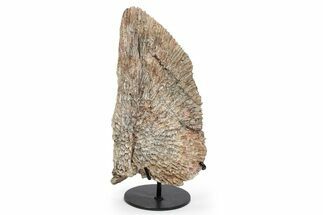This Specimen has been sold.
Huge, 16.7" Triassic Amphibian (Metoposaurus) Clavicle Bone - Arizona
This is an absolutely massive, 16.7" long clavicle bone of Metoposaurus, collected from a private ranch, located on the Chinle Formation of northeast Arizona. The Chinle Formation is Upper Triassic in age, meaning this fossil is approximately 220 million years old. The preservation of the bone is phenomenal, with relatively little restoration required to piece it back together. It comes from the right side of the body and would have articulated with the interclavicle and posterior end of the left clavicle, combined to make up the pectoral girdle. Our estimation is this came from a Metoposaur that would have been nearly 15 feet long!
It comes with a custom metal display stand.
There is some restoration to the posterior edge, as well as restoration to the middle of the clavicle which continues to the medial edge. The remaining repair/restoration is in the form of crack repair and gap fill which was required to piece the bone back together.
Metoposaurids were the ginormous ancestors of modern amphibians that managed to survive the Permian-Triassic extinction. These salamander-like creatures approached five feet in length on average, though they may have grown up to nine feet long. These amphibians are characterized by their broad, flat skulls, long limbs and paddle-like tails. Metoposaurs probably competed at the same feeding level with Phytosaurs, having very similar life styles and feeding strategies. Imagine a six-foot salamander that behaves like a crocodile, and you have a mostly accurate picture of Metoposaurids.
It comes with a custom metal display stand.
There is some restoration to the posterior edge, as well as restoration to the middle of the clavicle which continues to the medial edge. The remaining repair/restoration is in the form of crack repair and gap fill which was required to piece the bone back together.
Metoposaurids were the ginormous ancestors of modern amphibians that managed to survive the Permian-Triassic extinction. These salamander-like creatures approached five feet in length on average, though they may have grown up to nine feet long. These amphibians are characterized by their broad, flat skulls, long limbs and paddle-like tails. Metoposaurs probably competed at the same feeding level with Phytosaurs, having very similar life styles and feeding strategies. Imagine a six-foot salamander that behaves like a crocodile, and you have a mostly accurate picture of Metoposaurids.
SPECIES
Metoposaurus sp.
LOCATION
Private Ranch, Northeast Arizona
FORMATION
Chinle Formation
SIZE
16.7" long, 8.8" wide
CATEGORY
ITEM
#209973
We guarantee the authenticity of all of our specimens.
 Reviews
Reviews



















